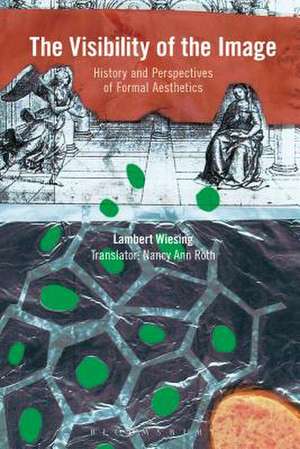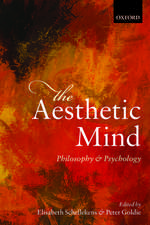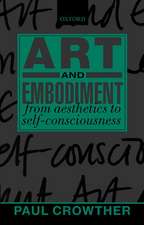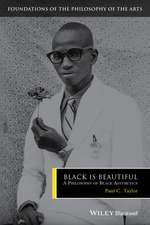The Visibility of the Image: History and Perspectives of Formal Aesthetics
Autor Lambert Wiesing Traducere de Nancy Ann Rothen Limba Engleză Paperback – 21 mar 2018
| Toate formatele și edițiile | Preț | Express |
|---|---|---|
| Paperback (1) | 238.40 lei 6-8 săpt. | |
| Bloomsbury Publishing – 21 mar 2018 | 238.40 lei 6-8 săpt. | |
| Hardback (1) | 774.62 lei 3-5 săpt. | |
| Bloomsbury Publishing – 21 sep 2016 | 774.62 lei 3-5 săpt. |
Preț: 238.40 lei
Nou
Puncte Express: 358
Preț estimativ în valută:
45.62€ • 47.76$ • 37.75£
45.62€ • 47.76$ • 37.75£
Carte tipărită la comandă
Livrare economică 05-19 aprilie
Preluare comenzi: 021 569.72.76
Specificații
ISBN-13: 9781350064027
ISBN-10: 1350064025
Pagini: 280
Ilustrații: 4 colour illustrations
Dimensiuni: 156 x 234 x 16 mm
Greutate: 0.4 kg
Ediția:NIPPOD
Editura: Bloomsbury Publishing
Colecția Bloomsbury Academic
Locul publicării:London, United Kingdom
ISBN-10: 1350064025
Pagini: 280
Ilustrații: 4 colour illustrations
Dimensiuni: 156 x 234 x 16 mm
Greutate: 0.4 kg
Ediția:NIPPOD
Editura: Bloomsbury Publishing
Colecția Bloomsbury Academic
Locul publicării:London, United Kingdom
Caracteristici
Analyses the work of neglected German thinkers Zimmerman, Riegl, Wölfflin and Fiedler alongside Merleau-Ponty and William Morris
Notă biografică
Lambert Wiesing, a prominent figure in image theory, is Professor of Philosophy at Jena University, Germany. He was President of the German Society for Aesthetics between 2005 and 2008. He was a Leverhulme Trust Visiting Professor at the University of Oxford, UK in 2013.TranslatorNancy Roth is an independent writer and translator based in the UK.
Cuprins
Table of ContentsList of FiguresForeword to the New Edition (2008) Introduction 1. The Beginnings of Formal Aesthetics: Robert Zimmermann (1824-1898)1. Formal Logic as a Model for Formal Aesthetics2. The Program: a Structural Theory of the Picture Surface3. Perspectives and Problems in Herbartianism2. Formal Aesthetics and Relational Logic: Alois Riegl (1858-1905)1. Transitions on the Pictorial Surface2. Kunstwollen (The Will to Art): Making Unlike Things the Same3. Intensional and Extensional Relational Logic3. The Logic of Ways of Seeing: Heinrich Wölfflin (1864-1945)1. The Relational Logic of an Image 2. Formal and Transcendental Aesthetics3. The Conditionality of Perception4. From the Way of Seeing to Visibility: Konrad Fiedler (1841-1895)1.The Paradigms of Formal Aesthetics2. Images Produced Technically: "For Their Visibility's Sake Alone"3. The Disappearance of Artistic Claims to Truth5. Phenomenological Reduction and Pictorial Abstraction: Maurice Merleau-Ponty (1908-19611. Formal Aesthetics and Reduction2. Visibility as Quiddity3.The Abstract Image6. From the Formula to Formative Discourse: Charles William Morris (1901-1979)1.Images about Images2. Images as Formulae3. The Formative Discourse of Fast Image SequencesBibliographyIndex
Recenzii
Lambert Wiesing's The Visibility of the Image is the most important book on the history of art history I know. It gives six case studies of six art historians: Zimmermann, Riegl, Wölfflin, Fiedler, Merleau-Ponty and Morris, in search of the roots of a certain version of broadly formalist vision of art history and an account of our engagement with pictures. A must-read for anyone interested in any of these six authors but also for anyone interested in (vaguely formalist) art history and our engagement with pictures.
Wiesing's landmark study reveals the deep historical roots of contemporary debates in image theory while at the same time opening up new philosophical resources. The reader is granted access to a distinctive tradition of enquiry that erroneously enriches our understanding of image perception.
A must read for anyone interested in the philosophical questions arising from pictorial representation.
In this fascinating work - part history of philosophically-minded aesthetics, part rumination on the nature of images, and part exploration of how the possibilities implicit in that nature have increasingly been exploited by new image-making technologies - Wiesing offers a deeply informed and theoretically searching exploration of one of the dominant phenomena of our age.
Wiesing's landmark study reveals the deep historical roots of contemporary debates in image theory while at the same time opening up new philosophical resources. The reader is granted access to a distinctive tradition of enquiry that erroneously enriches our understanding of image perception.
A must read for anyone interested in the philosophical questions arising from pictorial representation.
In this fascinating work - part history of philosophically-minded aesthetics, part rumination on the nature of images, and part exploration of how the possibilities implicit in that nature have increasingly been exploited by new image-making technologies - Wiesing offers a deeply informed and theoretically searching exploration of one of the dominant phenomena of our age.















